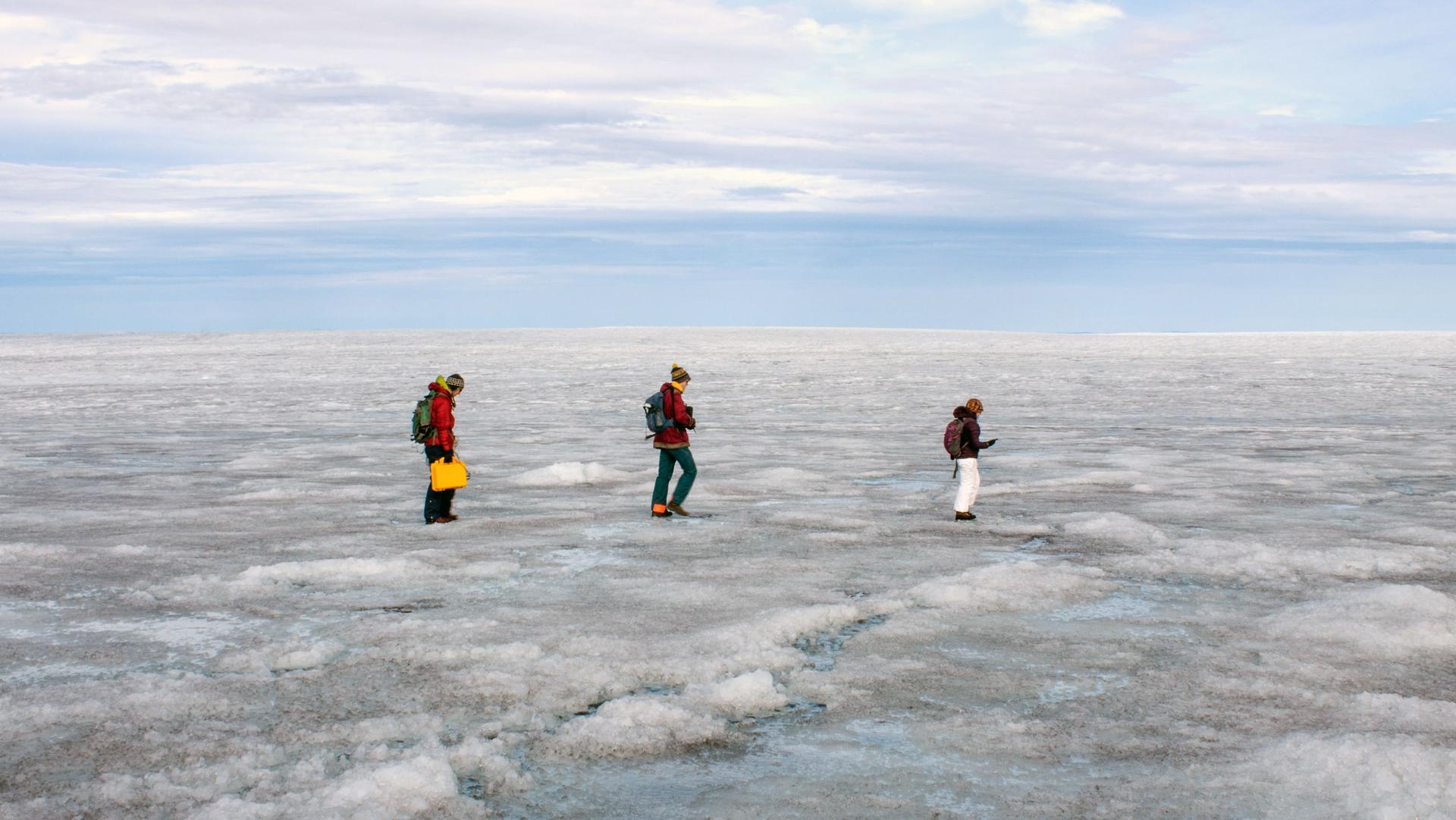As Greenland’s ice sheet melts, scientists push to learn ‘how fast’
The Greenland ice sheet holds enough water to raise sea levels roughly 23 feet if it were to melt completely. On a recent research trip, students Rosie Leone, Aidan Stansberry and Ian MacDowell used radar to map the bed of rock and soil below the ice sheet to help figure out how parts of the ice sheet may move toward the ocean.
This story comes to us through a partnership with the podcast and radio program Threshold, with funding support from the Pulitzer Center.
You might’ve read about it, heard about it, seen pictures of it, but nothing can prepare you for your first encounter with the Greenland ice sheet.
Mine comes while exploring outside the small town of Ilulissat, on the edge of a fjord on Greenland’s west coast. The sun is sparkling on Disko Bay opposite a steep, rocky hill. I’m following a boardwalk that snakes through a marshy field and down toward the shore, where I come upon a sign you’d only see on the edge of an ice sheet.
“Extreme danger,” it reads. “Do not walk on the beach. Death or serious injury might occur. Risk of sudden tsunami waves caused by calving icebergs.”
Duly noted, I think. Not going to the beach. Instead, I head up the hill.
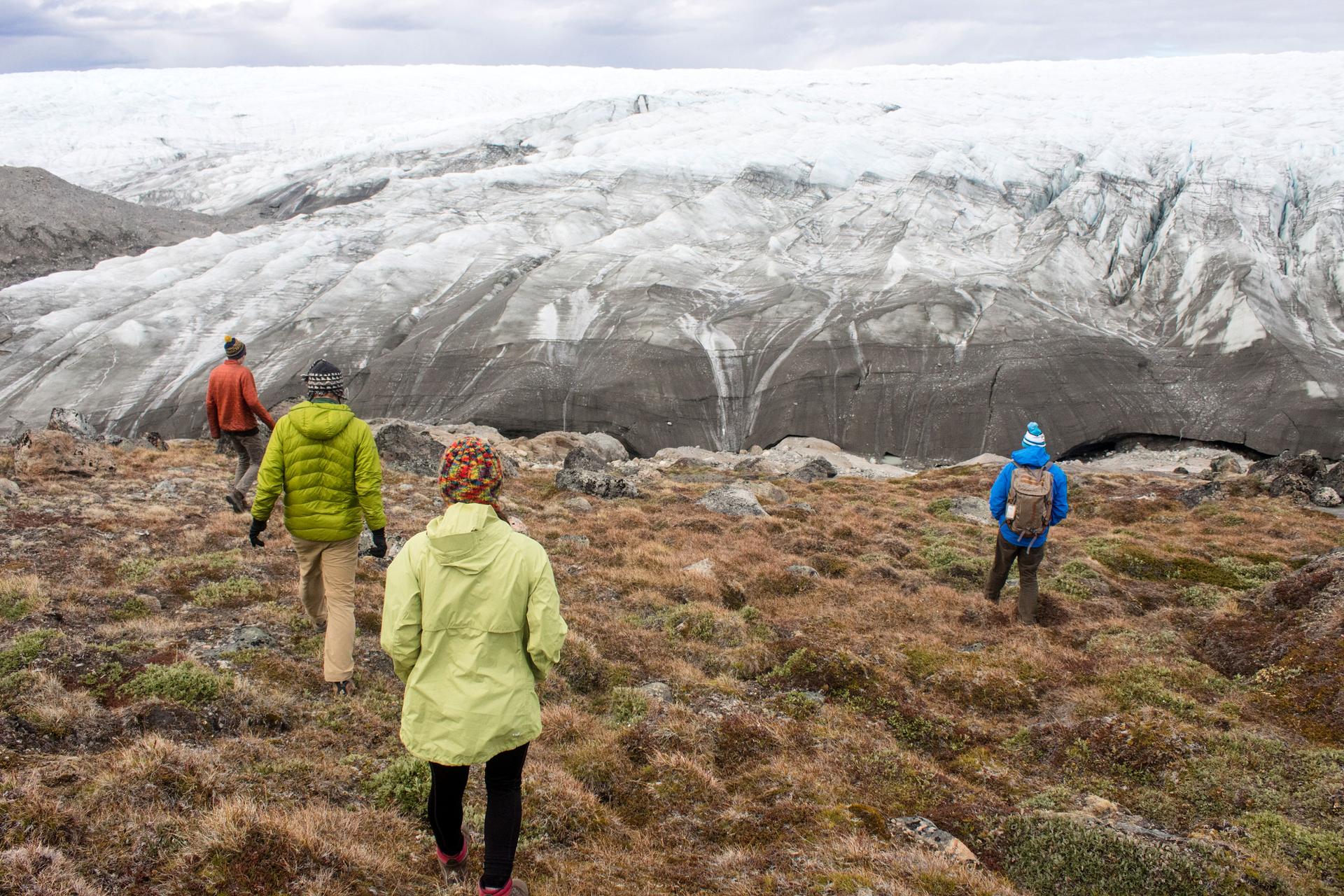
For a few minutes, all I can see is grey, weathered rock. But then I come around a curve, up over a little rise, and suddenly there it is, right in front of me: A range of massive white peaks, unlike anything I’ve ever seen.
I’m stunned. All I can do at first is laugh. It takes a while for my brain to register what it is I’m seeing — not actually mountains, but 3,000-foot-high peaks of solid ice.
It looks like it can’t even be real.
With every step, I can see farther, and more. Miles and miles of ice, jagged in some places, smooth in others. It looks a like it’s made of sugar or meringue. And the ice chunks are so big that they make their own shadows and shapes. It reminds me of the outline of a big city — like the skyline of Manhattan, made out of ice.
The ice sheet seems to stretch out forever, slowly rising from the edge of the ocean where I am to more than 10,000 feet in the center. The Greenland ice sheet is as big as Alaska, and some of the ice is more than 100,000 years old. All of it originally fell here as snow.
Everything about this ice is fascinating to me. I want to touch it — and walk on it. But like the beach below, it’s super dangerous here at the edge. The ice is shifting and cracking. So I have to wait.
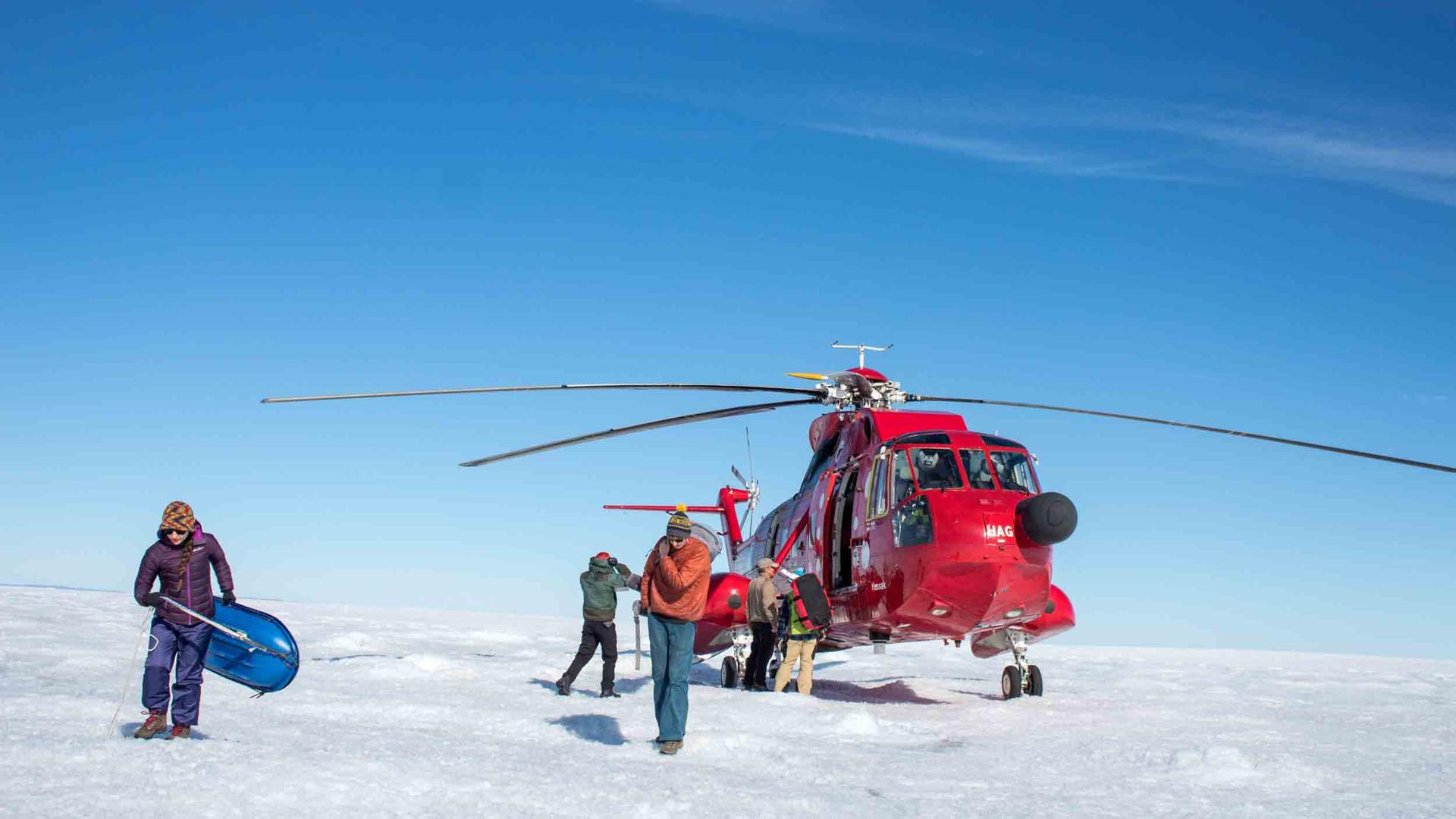
On the ice
A few days later a helicopter settles onto an endless expanse of white. My companions and I, three students and three professors, are pounded by the wind as we climb out. We’re the only splotches of color out here — it’s ice as far as we can see in all directions.
This is a research trip, and this team of scientists gets to work immediately. But I’m in awe of everything I see, hear and feel. The ice beneath us looks like frozen beer foam. It’s pockmarked with shallow holes, like honeycomb. Some of the holes are tiny, some large enough to lose your foot in, and they’re all filled with freezing cold water.
“Half of what we’re walking around on is not ice,” says Joel Harper, a glaciologist from the University of Montana, one of the people leading this trip. “It’s holes. Filled with water.”
In the summertime up here, melt water courses through holes and cracks and flows deep into the ice. Suddenly I really get how all this ice is a massive storehouse of fresh water.
“Yeah, there’s a lot of it here,” Harper says. “If you took all this ice and converted it to water and added it to the ocean, sea level would come up seven meters.”
Whoa, I’m thinking. Seven meters is roughly 23 feet. Adding that much water to the ocean would flood cities around the world, from Mumbai to New York, and displace millions of people. And it might well happen. It’s already starting to happen.
Related: If the Greenland ice sheet melts, what happens to New York City? This reporter went to find out.
The good news, Harper says, is we’re not going to lose the whole ice sheet all at once. But he and this team are trying to figure out just how this mountain of ice is moving into the sea, and how fast. It’s a field of study called ice sheet dynamics, and the first step in understanding it is to grasp the fact that this ice really is dynamic. It moves.
“It’s flowing like a fluid,” Harper tells me. And just like with any other fluid, gravity pulls it from high to low. So, in this case, from the middle of Greenland out to the edges, where it either melts in warmer temperatures or calves off into the ocean as icebergs.
Melting and calving at the edge of an ice sheet is normal, but — and this is a big but — normally the ice being lost at the edges is replaced at roughly the same rate by new snow falling in the middle.
Not anymore, though.
“Problem is,” Harper says, “we’re having more mass loss than we are gain at the moment.”
As we warm the planet, we’re knocking this ice sheet out of balance — it’s losing more ice than it’s gaining. That’s one of the reasons sea levels are rising these days, he says. But the huge challenge for Harper and other scientists is to try to figure out what might happen here under these new conditions. Is the ice more likely to melt at a steady pace, or in pulses? What role does the melt on the surface play? What happens if the ice sheet begins to break apart?
“This is where the motion part that we’re working on really comes to play,” Harper says.
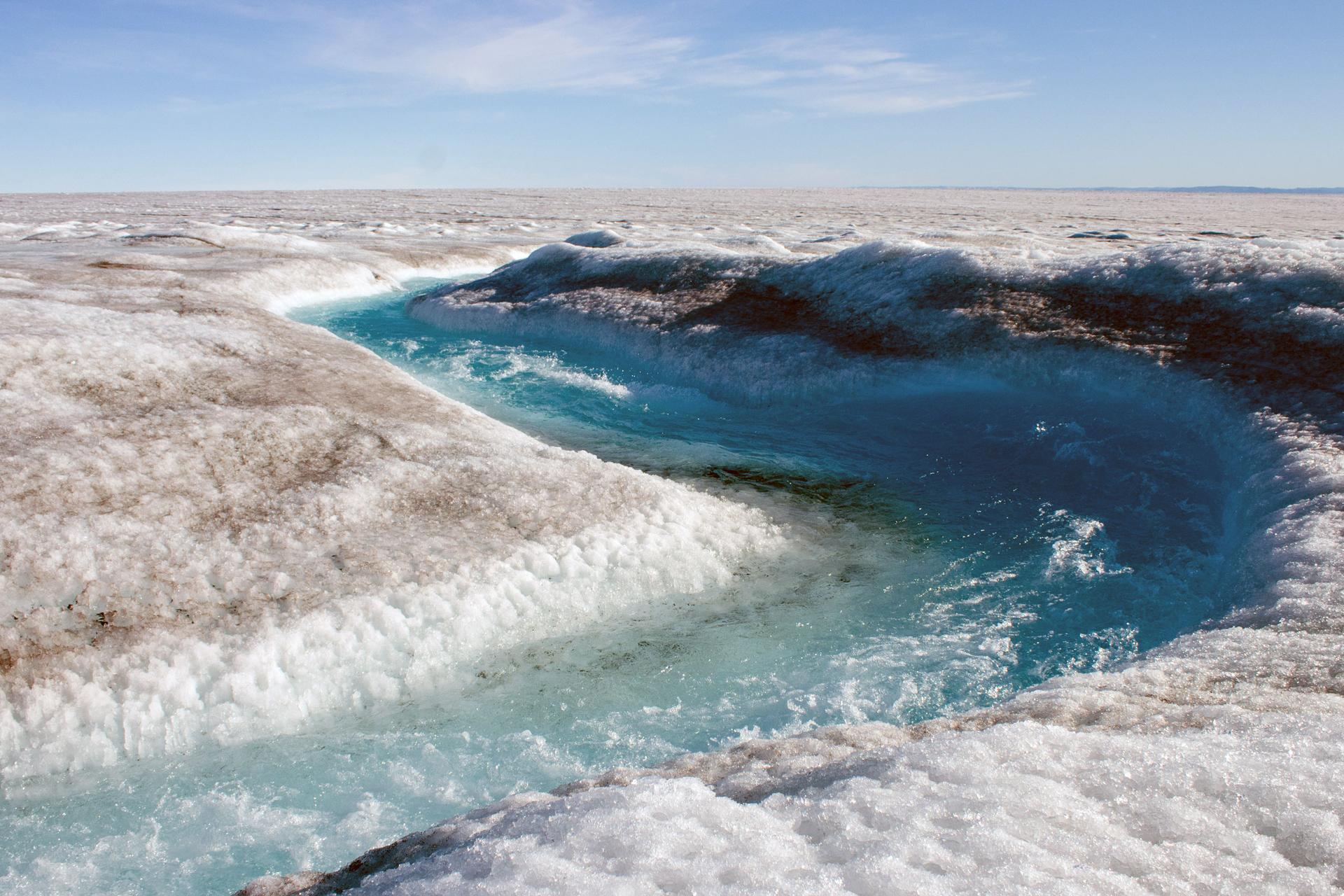
Team Radar
I’m not the only one on this trip who’s up on the ice sheet for the first time.
“Ah, I guess I’m in it now,” grad student Rosie Leone tells me with a wry laugh when I ask her what she was thinking when the helicopter dropped us off and flew can’t back out. “Sorta trapped!”
This is a daunting place to spend five days. And it’s not like she’s got the most interesting job here. Leone and undergrad Aidan Stansberry, both also from the University of Montana, are part of what I call Team Radar.
“Basically,” Stansberry tells me, “we … drag this radar around to map the bed.”
The bed is what the ice is sitting on top of. It can be made of different kinds of rock, soil, or sediment, it can be flat in one part and hilly in another. And part of what the team is trying to figure out is what happens when you combine all of that variability with the enormous weight of the ice sheet. How does the shape of the bed change how this thing moves?
To make the map of the bed, the students walk in straight lines a certain number of meters, stop, send down a radar pulse, log the data, and do it again. And again. And again. In the wind and the cold. All day long. It’s an important part of the work up here but, Leone says, it’s “a little boring, because we’re just walking and placing it down.”
She’s being nice. It’s not a little boring. It’s super boring. But Team Radar does get an occasional break. Like when Harper takes us all out to meet a moulin.
The belly of the beast
Harper warned us early on about these things called moulins — holes you can fall into on the ice sheet, never to be seen again. They’re pretty spooky, but they’re also intriguing portals into the belly of this massive beast. Because as we learned when we arrived, this ice isn’t a solid block from top to bottom. There are pools and rivers and lakes on the surface, but also inside and underneath it. Moulins are one of the ways water gets down inside, but Harper says we don’t yet have a detailed understanding of how the water moves once it gets there, and how that might affect the overall movement of the ice sheet.
We follow a winding blue stream, one of the many that form from melt water on the ice sheet in the summer. After a while, the sound turns from a trickle into a rush and we see it disappear into a big hole in the ice.
It’s incredible and incredibly dangerous.
You do not want to fall into that hole, Harper says. You would almost certainly never come back out.
We follow his advice and keep our distance.
But the moulin isn’t the only window here into the ice sheet’s deep interior. A little way off there’s a crevasse — a deep crack in the ice — and a spot where it’s safe enough for me to lay down on my belly and peer right down into it.
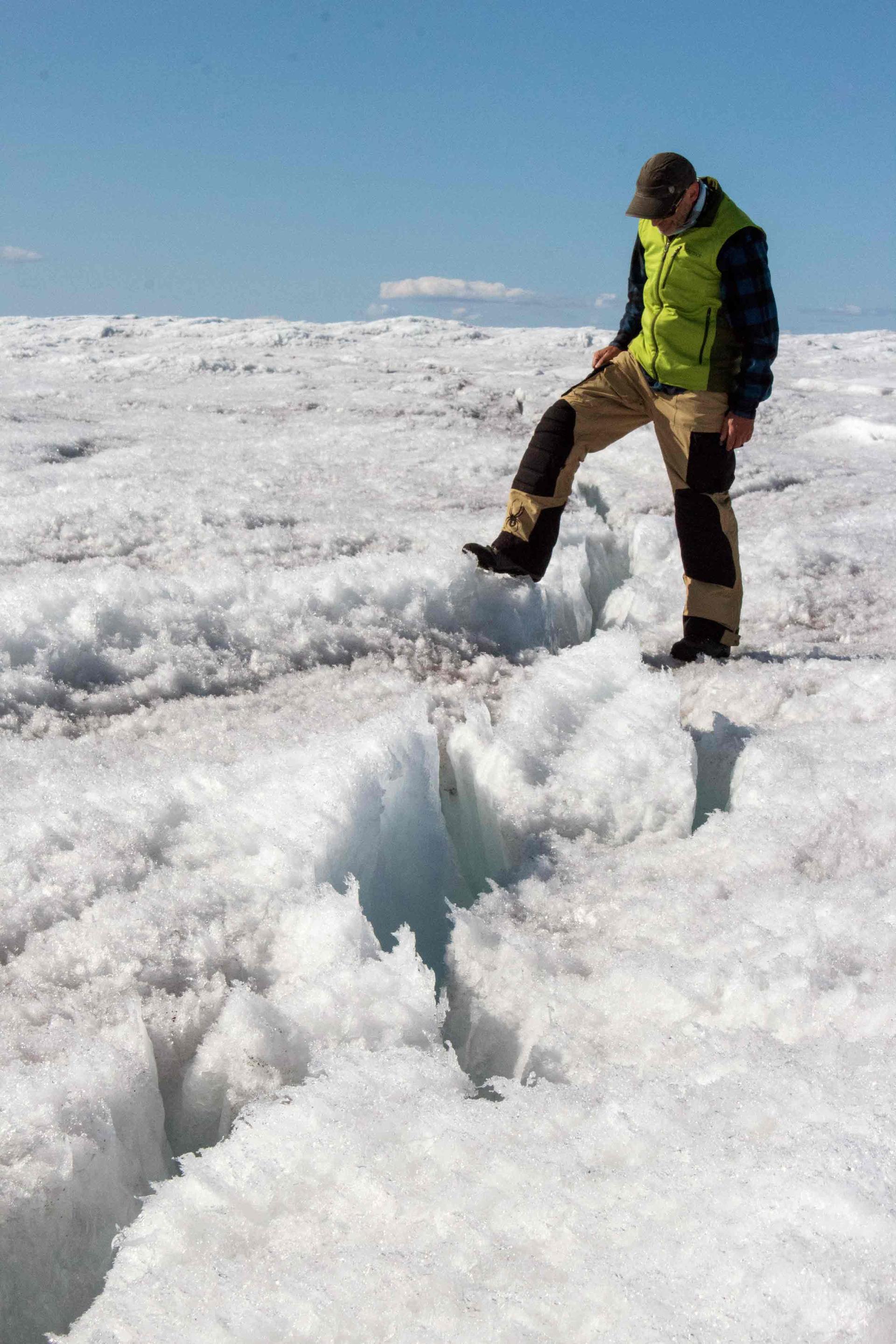
And that voice may be carrying a warning because Harper says what happens down at the bottom of the ice sheet is just as important as what happens up here on the surface.
Questions needing answers
“Twenty years ago, there was some debate as to whether or not water” — this surface melt we see — “could find its way to the bottom of the ice sheet … whether it could even get through a kilometer of really cold ice,” he tells me. “Since then we’ve learned that it absolutely does. But now we’re stuck with two new problems. One is, how? We don’t have that figured out entirely. And the second is, well, what are the impacts of that? What does it do to the sliding motion of the ice sheet?”
Related: In Greenland, a climate change mystery with clues written in water and stone
Harper and his team are searching for answers to these questions. Other researchers are pursuing related questions. What they all learn about the fate of this ice sheet could tell us a lot about the future of the whole world.
And Harper says it’s not just about potential sea level.
“Ice itself is a big part of the climate system,” he says. “Ice actually influences how the climate system works.”
One of the ways it does that is through albedo — the way the white ice reflects solar energy away from the Earth, back out into space. Right now, that process helps keep the earth comfortably cool for humans.
But when the ice here turns to water, it turns from a light surface that reflects heat to a dark surface that absorbs it. It’s the same thing that’s happening as sea ice melts on the Arctic Ocean. And that change just adds to the warming we’re already causing. That’s why there’s some urgency here, to get a better understanding of the processes that are turning this big hunk of planet-cooling ice into water.
“What really matters here is how fast,” Harper says. “If it takes three or four millennia to get a large amount of melt from Greenland into the ocean, that’s a completely different societal issue [than] if it’s a century, or two, or three.”
Seeing and hearing all this water move around up here really brings home that Harper’s team and I are standing on a pivot point of our future. The Greenland ice sheet is spectacularly beautiful and unreal. It almost feels like another world. But even though most of us don’t think about it much, it is a key part of this planet, something that has helped regulate Earth’s temperature for all of human history.
As our pollution warms the planet up, that key role is starting to diminish. And, Joel Harper says, people very far away will start to notice.
“Even if you live in the southern latitudes somewhere,” Harper says, “if there’s a big change in the poles, it will impact how the climate system works, and will ultimately work its way down to impacting you.”
Some 600 million people live in coastal areas less than 10 meters above sea level. That’s 32 feet. As the Greenland ice sheet melts away, an awful lot of those people are going to have to find somewhere else to live. That’s a recipe for intense societal disruption — hunger, disease and conflict.
That’s what lies in the uncertainty about Greenland’s future. That’s how the science Harper and his team are doing here intersects with questions that have huge implications for all of us, wherever we live.

Amy Martin is the executive producer of the podcast and radio program Threshold.
Read more in The Big Melt series:
An environmental newspaper fights for press freedom in the Russian Arctic
As the Arctic warms up, a ‘new ocean’ is bringing new commerce to the top of the world
Ice is us: Alaska Natives face the demise of the Arctic ice pack
The Arctic’s Sámi people push for a sustainable Norway
Arctic permafrost is starting to thaw. Here’s why we should all care.
An Alaskan village is falling into the sea. Washington is looking the other way.
In Iceland, a shifting sculpture for a changing Arctic
Take our Arctic quiz.
